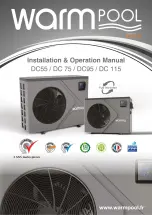
22
REFRIGERANT PIPING cont.
• Excessive suction line pressure drop causes loss
of compressor capacity and increased power
usage resulting in reduced system efficiency.
Excessive pressure drops in the liquid line can
cause the liquid refrigerant to flash, resulting in
faulty expansion valve operation and improper
system performance. In order to operate
efficiently and cost effectively, while avoiding
malfunction, refrigeration systems must be
designed to minimize both cost and pressure loss.
The pipe sizes must be selected to meet the
actual installation conditions, and not simply
based on the connection sizes at the
evaporator and/or condensing unit. Refer to
TABLES RP-1 through RP-4 for connection
size information.
Equivalent Line Length:
All line lengths discussed in this manual, unless
specifically stated otherwise, are Equivalent Line
Lengths. The frictional pressure drop through
valves, fittings, and accessories is determined by
establishing the equivalent length of straight pipe
of the same diameter.
Always use equivalent
line lengths when calculating pressure drop
.
Special piping provisions must be taken when
lines are run underground, up vertical risers, or in
excessively long line runs.
Liquid line sizing:
• When sizing the liquid line, it is important to
minimize the refrigerant charge to reduce
installation costs and improve system reliability.
This can be achieved by minimizing the liquid
line diameter. However, reducing the pipe
diameter will increase the velocity of the liquid
refrigerant which increases the frictional pressure
drop in the liquid line, and causes other
undesirable effects such as noise. Maintaining
the pressure in the liquid line is critical to
ensuring sufficient saturation temperature,
avoiding flashing upstream of the TXV, and
maintaining system efficiency. Pressure losses
through the liquid line due to frictional contact,
installed accessories, and vertical risers are
inevitable. Maintaining adequate sub-cooling at
the condenser to overcome these losses is the
only method to ensure that liquid refrigerant
reaches the TXV.
• Liquid risers decrease head pressure. If the
evaporator section is below the condenser, and
the liquid line does not include risers, the
gravitational force will increase the pressure of
the liquid refrigerant. This will allow the
refrigerant to withstand greater frictional losses
without the occurrence of flashing prior to the
TXV.
• A moisture indicating sight glass may be
factory installed in the liquid line to indicate the
occurrence of premature flashing or moisture in
the line. The sight glass should not be used to
determine if the system is properly charged.
Use
temperature and pressure measurements to
determine liquid sub-cooling, not the sight
glass.
Liquid Line Routing:
Care should be taken with vertical risers. When
the system is shut down, gravity will pull liquid
down the vertical column, and back to the
condenser when it is below the evaporator. This
could potentially result in compressor flooding.
A check valve can be installed in the liquid line
where the liquid column rises above the
condenser to prevent this. The liquid line is
typically pitched along with the
suction line, or hot gas line, to minimize the
complexity of the configuration.
Liquid Line Insulation:
When the liquid line is routed through regions
where temperature losses are expected, no
insulation is required, as this may provide
additional sub-cooling to the refrigerant. When
routing the liquid line through high temperature
areas, insulation of the line is appropriate to
avoid loss of sub-cooling.
Liquid Line Guidelines:
• In order to ensure liquid at the TXV, frictional
losses must not exceed available sub-cooling. A
commonly used guideline to consider is a system
design with pressure losses due to friction
through the line not to exceed a corresponding 1-
2°F change in saturation temperature.
















































